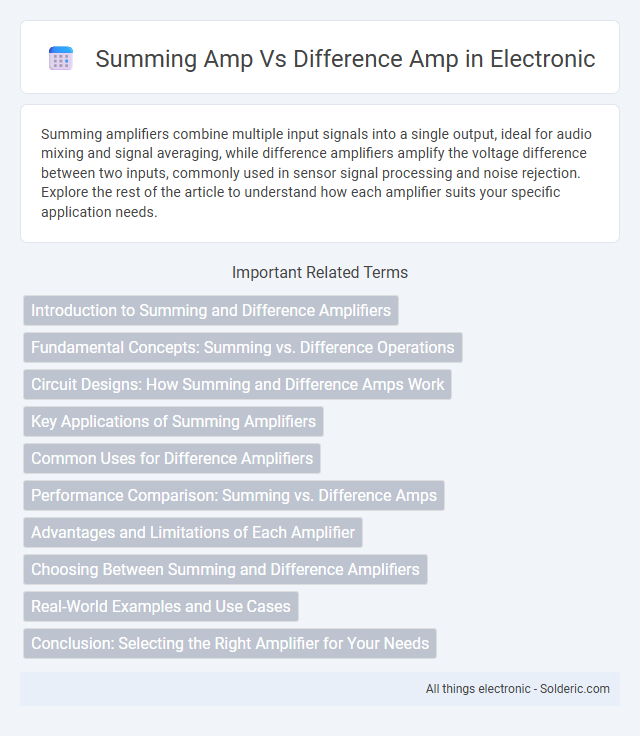Summing amplifiers combine multiple input signals into a single output, ideal for audio mixing and signal averaging, while difference amplifiers amplify the voltage difference between two inputs, commonly used in sensor signal processing and noise rejection. Explore the rest of the article to understand how each amplifier suits your specific application needs.
Comparison Table
| Feature | Summing Amplifier | Difference Amplifier |
|---|---|---|
| Function | Adds multiple input voltages | Outputs voltage proportional to difference between two inputs |
| Input Configuration | Multiple inputs summed at inverting terminal | Two inputs, one at inverting and one at non-inverting terminal |
| Output Voltage (Vout) | Vout = -Rf x (V1/R1 + V2/R2 + ...) | Vout = (Rf/R1) x (V2 - V1) |
| Gain Control | Set by feedback resistor Rf and input resistors R1, R2,... | Set by matching resistor pairs: Rf, R1 (both sides) |
| Use Cases | Signal mixing, audio summing, weighted addition | Signal conditioning, noise rejection, subtracting signals |
| Common Mode Rejection | Low | High |
Introduction to Summing and Difference Amplifiers
Summing amplifiers combine multiple input signals into a single output voltage proportional to their weighted sum, often used in audio mixing and signal processing. Difference amplifiers output the voltage difference between two input signals, providing essential noise rejection in differential signaling applications. Both amplifier types are based on operational amplifier configurations and are fundamental in analog circuit design for signal conditioning.
Fundamental Concepts: Summing vs. Difference Operations
Summing amplifiers combine multiple input signals into a single output voltage proportional to their algebraic sum, making them ideal for audio mixing and signal averaging. Difference amplifiers, on the other hand, output a voltage corresponding to the difference between two input signals, crucial for noise cancellation and differential signal processing in instrumentation. Understanding the distinct operational principles of summing and difference amplifiers enables precise control in analog circuitry for signal conditioning and measurement applications.
Circuit Designs: How Summing and Difference Amps Work
Summing amplifiers combine multiple input voltages into a single output voltage, using an operational amplifier with resistors arranged to sum signals proportionally. Difference amplifiers produce an output voltage proportional to the difference between two input voltages, relying on precision resistor matching to reject common-mode signals effectively. Both circuits use op-amps but differ in resistor configurations to achieve summation or subtraction needed for applications like audio mixing or sensor signal conditioning.
Key Applications of Summing Amplifiers
Summing amplifiers are essential in audio mixing consoles, sensor signal processing, and data acquisition systems where multiple input signals must be accurately combined into a single output. These amplifiers enable precise addition of voltages from different sources, preserving signal integrity and enabling complex waveform generation. Your projects benefit from summing amps when you need to integrate multiple sensor outputs or audio channels with minimal distortion and high linearity.
Common Uses for Difference Amplifiers
Difference amplifiers are commonly used in sensor signal conditioning, instrumentation, and audio applications to accurately amplify the voltage difference between two input signals while rejecting common-mode noise. This capability makes them ideal for measuring small differential signals in noisy environments, such as strain gauge readings or ECG monitoring. Your design benefits from improved signal integrity and reduced interference when using difference amplifiers for precise data acquisition.
Performance Comparison: Summing vs. Difference Amps
Summing amplifiers combine multiple input signals into a single output, offering high linearity and low noise suited for audio mixing and sensor signal aggregation. Difference amplifiers excel at rejecting common-mode noise and amplifying the voltage difference between two inputs, making them ideal for precise measurement applications in noisy environments. While summing amps prioritize signal combination with minimal distortion, difference amps focus on accuracy and noise rejection, influencing their performance based on the application requirements.
Advantages and Limitations of Each Amplifier
Summing amplifiers excel at combining multiple input signals into a single output, offering precise voltage addition with minimal distortion, ideal for audio mixing and signal conditioning. Difference amplifiers provide superior common-mode noise rejection by amplifying the voltage difference between two inputs, making them essential in sensor signal processing and differential signal amplification. Your choice depends on whether you need to combine signals efficiently or isolate differential inputs to enhance signal integrity.
Choosing Between Summing and Difference Amplifiers
Choosing between summing and difference amplifiers depends on the specific signal processing requirement; summing amplifiers efficiently combine multiple input voltages into a single output, ideal for audio mixing or sensor data aggregation. Difference amplifiers excel at extracting the voltage difference between two signals, providing high common-mode rejection useful in instrumentation and noise reduction applications. Selecting the appropriate amplifier type improves signal integrity and system performance by matching the amplifier function to the desired signal manipulation.
Real-World Examples and Use Cases
Summing amplifiers excel in audio mixing consoles by combining multiple input signals into a single output without signal loss, crucial for live sound engineering and music production. Difference amplifiers find key applications in sensor signal conditioning, such as isolating differential voltages in medical devices like ECG machines to improve signal accuracy. Industrial automation systems also rely on difference amps to measure small voltage differences in noisy environments, enhancing precision in motor control and process monitoring.
Conclusion: Selecting the Right Amplifier for Your Needs
Choosing between a summing amplifier and a difference amplifier depends on your signal processing requirements; summing amps excel at combining multiple input signals into one output, ideal for audio mixing or sensor data integration. Difference amplifiers provide precise measurement of the voltage difference between two inputs, making them indispensable in instrumentation, noise rejection, and differential signaling applications. Evaluating factors like signal type, noise sensitivity, and desired output ensures optimal amplifier performance tailored to your electronic circuit design.
summing amp vs difference amp Infographic

 solderic.com
solderic.com